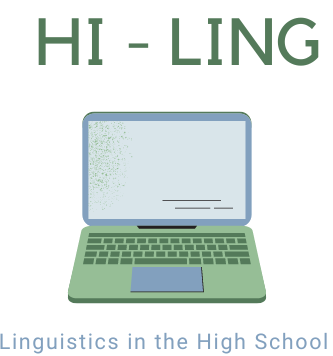HI-LING
LINGUISTICS IN THE HIGH SCHOOL

UNIT 2: VIOLATION OF MAXIMS
Lesson 3: Multilingualism: Case study Switzerland, example Biel/Bienne
Definition: Multilingualism means that two or more languages can be used in communication situations. This applies both to individual language use and to language use in contact with authorities and institutions. This also includes regional languages or dialects.
Key Concepts
-
Various multilingualisms
-
Multilingualism in Switzerland
-
Living bilingualism in Biel/Bienne
UNIT 1: Multilingualism in Switzerland
Territorial multilingualism: The coexistence of several languages on one and the same territory.
Institutional multilingualism: Languages of members of an institution or of business partners are treated equally, as is the case in the European Union or at universities.
Social multilingualism: The use of several languages within a society, e.g. in multi-ethnic neighbourhoods.
Consensual multilingualism: Countries such as Belgium, Canada, South Africa and the Swiss practise consensual multilingualism. This means that languages coexist within a state. This coexistence of languages is regulated by law. If the coexistence of languages is not consensual, i.e. if a dominant group imposes its language on a minority group, this leads to linguistic discrimination or assimilation.
How does multilingual Switzerland work?
Multilingualism in Switzerland is an essential component of Swiss identity and a model for dealing with cultural and linguistic diversity.
It contributes to unity and understanding between the different regions of the country. Switzerland protects its national languages through the Federal Constitution. All four official languages have the same legal status and citizens can communicate with the authorities in their mother tongue. The education system adapts to the language of the region. Areas with two official languages offer bilingual teaching models. Foreign language teaching begins in year 5 at the latest and a second language, usually English, is taught in year 7 at the latest. State-supported media and the Federal Council are linguistically balanced and laws are published in all official languages.
Multilingualism is increasing significantly in Switzerland. In addition to the four national languages and dialects, up to 250 languages are spoken. What is most striking is that English is gaining a significant share and almost feels like the fifth national language. German-speaking Switzerland stands out not only because of the number of languages spoken, but also because of the functional importance of Swiss German compared to the standard language. Swiss German is mainly spoken in family and private contexts, while the standard language is used in formal areas such as education, politics and business - a form of diglossia.
French is the national language, which has gained in importance since 1970, mainly due to immigration from Romance-speaking regions. Italian remains the third most spoken language, with many young people leaving their language region for economic reasons. Rhaeto-Romanic, spoken in Graubünden, is experiencing a decline despite government support measures, while tourism is increasing the proportion of German speakers in Rhaeto-Romanic communities.

Activity 1: Discussion
Discuss in pairs or threes:
1. Are you also multilingual?
2. How do you experience social multilingualism in everyday life, in which situations?
3. Do you know expressions that are used throughout Switzerland or in two language areas or even worldwide?
UNIT 2: Living Bilingualism in Biel/Bienne
From 06.00-08.00 in this video, the special language situation is discussed. Watch it before reading the following text.
Biel/Bienne is the largest bilingual city in the country. It has been officially bilingual since 1996. There is a consensual bilingualism in Biel/Bienne, with German and French being recognised as official languages with equal status. Around 57% of the inhabitants speak German, while the proportion of French speakers is around 43%. The city, at the interface between German- and French-speaking Switzerland, practises the "Biel/Bienne model", a communication rule in public spaces in which the person who starts a conversation determines the language and the other person adapts, even if they do not speak the language equally well.
This adaptation of the language is a sign of respectful interaction in everyday life. The city has German and French-speaking schools, some of which offer bilingual lessons. The Filière Bilingue project, which offers bilingual education from nursery to High School, was launched in 2018.
The practised, consensual bilingualism is reflected in everyday life, the economy and cultural diversity. Public transport, buildings and street names are labelled bilingually. The political parties, media and cultural institutions are bilingual. Bilingualism is seen as an advantage for the business location, especially for the globally networked watch and precision industry. Enrique Munoz Garcia, a Chilean photographer, describes Biel as the most cosmopolitan city in the world and documents this in a permanent exhibition. Intercultural understanding and cooperation between the German- and French-speaking communities are promoted by numerous meeting points in the neighbourhoods.
The oldest autonomous youth centre in Switzerland, "Chessu" or “la Coupole”, offers bands and artists a platform. EHC Biel represents the city's self-confidence in ice hockey with the slogan: "Ici c'est Bienne"! (“That’s Biel”!)
Overall, bilingualism is an important aspect of Biel/Bienne's identity, attracting people from over 140 countries around the world. Biel/Bienne is an outstanding example of bilingualism in action in Switzerland.
Solve the following quiz. You can use this link for support:

Activity 2: Quiz
Final thought for this lesson
Living in a multilingual society offers numerous opportunities, as language is an expression of culture and lifestyles, multilingualism opens up horizons for other cultures and promotes understanding and tolerance.